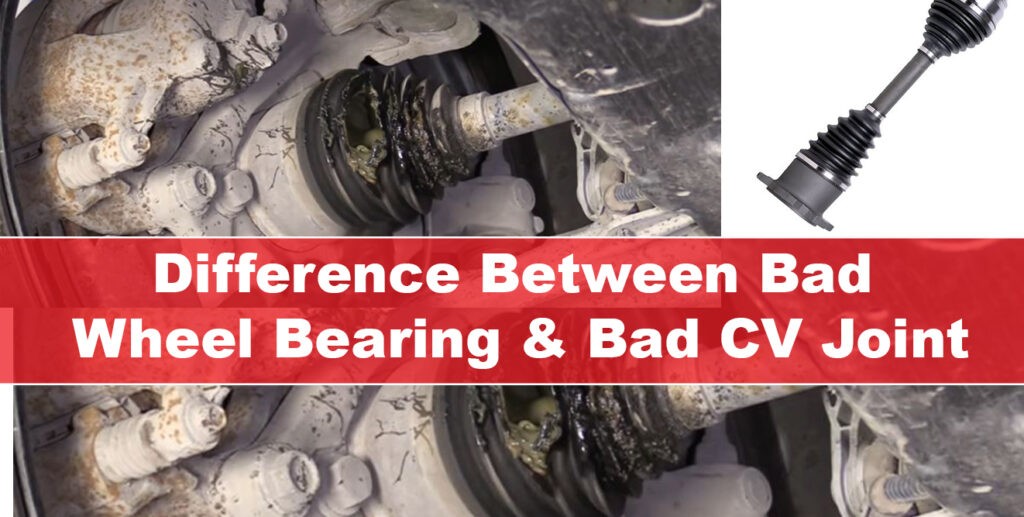Constant-velocity joints popularly called CV joints plays an important role in the movement of a car. Essentially, it allows a drive shaft to transmit power at a varied angle while maintaining a constant rotational speed while reducing friction.
When the CV joints start wearing off, the symptoms may be likened with that of a bad wheel bearing, although, there’re sharp contrasts. So, today, I will be sharing with you how to tell the difference between a bad wheel bearing bad CV joint.
Constant-velocity joints are protected by a rubber boot, and once there is a crack on the boot, pollutants can fall in, this could make the joints get damaged. Related: Where can I get my flywheel resurfaced near me US?
But before it is completely in ruins, it presents some symptoms. Acting swiftly will prevent other issues that may affect transmission
CV joints are in charge of delivering power from the transmission to the wheels of your car with little friction, having it as one of the constant vehicle issues motorists come upon now and then. Joint issues can be detected through some of these symptoms listed below. Related Article: Causes of transmission problems after CV joint replacement with a Bad CV axle Vibration effect.
How to test CV joints (signs of bad CV joints)
As soon as your CV joint starts wearing off, some evident indications include the following:
1) Vibrations
This is one of the clear signs that you need to change your CV joints. Once the CV joints are bad, you’ll notice that your car will be jerking (vibrating) while you’re driving.
A confirmation of this as you try to accelerate, the vibration increases, and the vehicle performance would be limited.
2) Grease leakage
Another obvious sign that you should replace your CV joints is as soon as you start seeing grease leaking. The leakage could be from the boots which are what is protecting and preventing pollutants from entering the joints. Once it starts leaking, it could mean that the boot is getting old or bad.
3) Cracking Noises while in motion
You can easily tell if it is a joint fault from the cracking noise you hear while in motion. This could arise from a front-wheel-drive vehicle’s inner joint or a rear-wheel-drive vehicle’s inner and outer joints
How to check a CV joint for play
There’re ways to check a CV joint for play. To do this, follow these steps:
#1. Thorough inspection
The simplest way to check a CV joint for play is to inspect the rubber boots Placed close to the wheel on the axle shaft. The boot has been weakened or damaged if it shows symptoms of deterioration or is covered in grease.
#2. Check to see if there is a jerking sound when accelerating
You can do this by turning the steering wheel completely to one side and accelerate gently while spinning in a fast session. Do the same in the opposite direction. If you hear some cracking sounds, it is time to replace the CV joints.
How to check which CV joint is bad: what you need to do
- Checking your CV joint to see if it is good or bad
Sometimes, you may notice some of these problems listed as symptoms of a bad CV joint, yet, the joints are still very much okay.
So, the perfect way to find out any fault in the joints, especially, which of the joints is bad is by taking a proper look at the CV joints.
If they’re worn or you see grease on the wheels, then you should call your auto mechanic or better still, take a long drive to see if there are some other signs you might notice while in motion.
Related Articles:
How to tell the difference between bad wheel bearing bad CV joint
A wheel bearing is made up of a race of ball bearings that are held together by a steel rod. This is found in the centre of your wheels.
The wheel bearings are tightly packed inside this hub and ride on a metal axle shaft, reducing the friction while the wheel rotates.
The main function of the bearings is for your wheels to function properly—specifically, for the hub, tire, and components to work together respectively.
Most times, many people mistake bearing problems with that of CV joints. Although they are similar, the sounds are different.
A bad wheel bearing makes a humming, squealing and growling noise while a bad CV axle or Joint on the other hand will make a clear recognizable clinking noise when the joint is loose or has worn out.
You can tell the difference between bad wheel bearing, and bad CV joint when you check for play in the wheels. To achieve a better result, see that your car is, jacked. Be careful, ensure you did not park on bumpy ground.
For more clarity on the different noises that distinguish between bad wheel bearing and a bad CV joint please watch this video below.
Can a bad CV joint affect the transmission?
Yes! A bad CV joint can affect transmission when the car is vibrating. The frequent shaking can put much stress on bearings, and other components, by so doing, CV joints will be unable to balance appropriately during rotation. The vibrations will increase the faster you accelerate.
When vibrations are too strong, the car gets hard to control, and transmission will be affected too, which is risky.
What causes CV joint noise when driving straight?
#1. Inadequate lubrication
When your CV joints aren’t properly lubricated, friction builds up, stopping your CV axle from freely rotating. If your CV joints aren’t properly lubricated, they can produce a noise every time the axle starts turning. This implies that anytime you drive your car, you will hear noise from the inner CV joints.
#2. Worn axles
When the axles are bad it will cause CV joints noise. So, once you notice this, quickly, change the worn-out axles and, the noise will cease.
Inner CV joints failure symptoms
On each CV axle, there are inner and outer CV joints. The joints allow the CV axle shaft to move up and down when the vehicle travels over obstacles. The front wheels can rotate since the exterior joints rotate too.
One of the indicators of a deteriorating inner CV joint is vibration during acceleration.
Other signs to watch include a clicking sound when turning the car steering and a Creaking sound on acceleration.
CONCLUSION
CV joints are an essential component in a vehicle. You must replace it once you start seeing those obvious symptoms of a bad CV joint before it becomes too late.
Due to fact that it relies on the grease inside the boot to function properly, keeping it clean and free of impurities or leaks will greatly extend the life of a front-wheel-drive transmission system.
Hi dear, I am Gift Dennis I have been working as a Radiographer for over 8 years, but I switch my profession to what I love which is auto body part repairs and I recently got my automotive diploma last August 2020 as an auto-body repair technician. I love fitness and everything about cars, so here is where I share my expertise and experiences with those who wish to hear about them.


